Last month I began using tea bags filled with fertilizer to feed my bonsai. Unfortunately, it only took a few days for me to realize that this technique didn’t work well as implemented. The bags started disappearing immediately. Critters tore through some of the bags and carried others away completely, leaving behind the toothpicks that were meant to keep the bags in place. Somehow they removed all of the bags from my best trees and only a few of the bags on the developing trees – I won’t even try to solve that one. Instead, I’ll go back to my time-tested fertilizer method – clumps of cottonseed meal and fish emulsion.
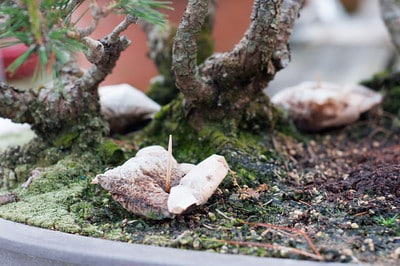
Tea bags intact on a pine forest
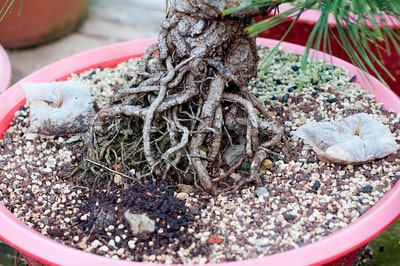
Tea bags on an exposed root pine
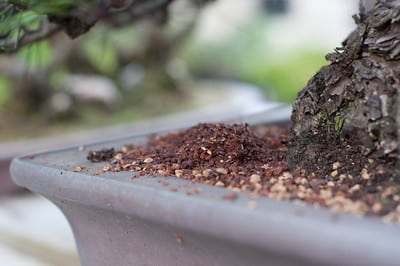
Cottonseed meal on a pine
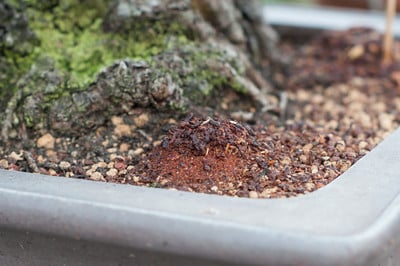
More cottonseed meal
I usually start feeding my trees at some point between late January and mid March depending on the weather and the variety. If I’ve repotted a tree, I wait about 4 weeks before feeding it. I start by placing one or two clumps of cottonseed meal and add additional clumps every 1-3 weeks later until the majority of the pot is filled with fertilizer.
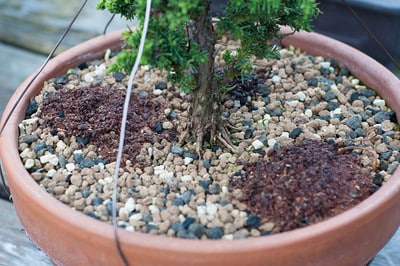
Cottonseed meal feeding a recently separated cryptomeria
I supplement the cottonseed meal with fish emulsion (see “Bonsai Fertilizer” for details). Fish emulsion is a great, if stinky, fertilizer that I’m comfortable using on all bonsai varieties. I usually apply fish emulsion weekly, though I might apply it more or less frequently at various times depending on the season, the weather and the variety.
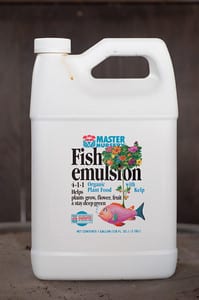
Fish emulsion
Ebihara fed his trees with diluted liquid fertilizer every three days (I don’t know what type of fertilizer he used). Others primarily rely on dry fertilizer that releases food whenever the trees are watered. I haven’t noticed big differences between liquid, dry, or other categories of fertilizer, but I do find that consistent application leads to the best results. And the best results, of course, depend on the goal of the fertilizing program. If I’m trying to increase the size of the trunk, I fertilize a lot. If I’m trying to ramify delicate branches on deciduous varieties, I fertilize very lightly and only after new leaves have hardened off.
As for the tea bags, I haven’t completely given up. I may yet try chili powder or some other caustic agent that’s harmful to vermin but safe for trees. And if I can get this right, I will celebrate and then post the results.
Subscribe to Bonsai Tonight
New Posts Delivered Every Tuesday and Friday
bonsaijapan says
Any idea of the type of vermin that is taking away your teabags? Rats, birds, or is it something larger?
David Chapman says
I am having success using tea bags with Osmocote poured inside. Two scoops per bag. If nothing else, it keeps the pot clean of all those little fertilizer pellets.
However, it is really hard to tell as I think my trees have hit Summer dormancy? They are not taking up water as fast as they were in March and temperatures are already in the 90s here in South Carolina with thunder storms almost weekly.
Daniel Dolan says
Jonas:
What does the cottonseed meal provide…chemically?
This goes back to my previous question about Fish Emulsion being so low in P and K….does the cottonseed meal make up for that?
I understand your earlier reply that different trees require different feedings based on any number of factors………but they have to need more phosphorous and potassium than is available in 5-1-1 fish emulsion….don’t they? Dyna-Gro’s Spring Fertilizer “Bloom” has 3-12-6!
And it seems like half the world uses Peter’s 20-20-20.
Your comments appreciated.
D/D
Chicago
Tom Knoblauch says
Jonas,
I too have gotten on the Tea bag craze this spring. I suspect crows and jays as i have found their beak holes in the bags. They haven’t removed them though. I put the dango in the bags moist and a few days old, like i would if i was making a ball. Perhaps this mouth-full discouraged the inquisitive birds.
Organic fertilizer Q. are handled in the book Teaming with Microbes. Way to simply put, 20-20-20 chemically may feed the tree. Organic fertilizer feeds the microbes in the soil that supports the tree. Chemical fertilizers, fungicides, and insecticides all harm these microbes. This book has important concepts for the bonsai grower using inorganic soil mix with organic fertilizers.
brendenstudio says
Jonas–have you tried fertilizer cups or cages yet? I started experimenting with them two years ago with my organic ‘poo’ balls and they seem to work very well by keeping the flies off the fertilizer. This is important because it’s the maggots that attract birds and other pests and if the birds don’t get the maggots, they eventually feed on most of the fertilizer cake all by themselves. The trick is to cover the balls with the cups or cages before flies have a chance to lay their eggs.
John says
Hi Jonas,
I use the tea bags with pretty good success ! I make U -shape pins out of alum wire to hold the bag in place. Usually the wire goes in the soil about 1-1 1/2″ deep. I do have raccoons and squirrels but they don’t seem interested in the bags ! I half fill the bags with a chicken based fertilizer and also weekly feed with fish and seaweed. Plus I use rapeseed cakes in between the bags ! My trees do quite well with this mix !
Jonas Dupuich says
@bonsaijapan – my best guess is raccoons as I’ve seen large footprints around.
@ David – it seems a bit early for summer dormancy. The important thing is watching to see what the trees need and watering as much, or as little, as necessary.
@ Dan – I’ll defer questions about plant chemistry to the experts as I don’t know much about the topic.
@ Tom – thanks for the explanation and the recommendation – I’ll have to check this book out.
@ Greg – I have tried the cages. They’ve been about as successful as the bags – some make it through the season and some don’t. I think you’re right about the fly larvae attracting the vermin. What strikes me as funny is that it’s very rare that these creatures go for the larvae in the cottonseed meal, yet they grab the dango within a day or two of application. I think they must find something in the dango to be very appealing.
@ John – I’m happy to hear the bags are working well. I heard another suggestion for painting the tea bags with high Scoville pepper extract – I might give that a try.